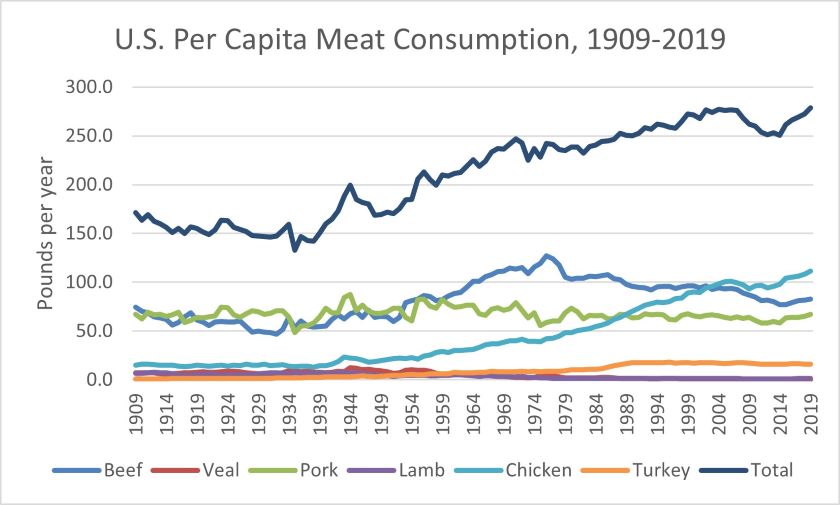Drivers of U.S. Per Capita Meat Consumption over the Last Century

USDA’s Economic Research Service (ERS) has data that tracks per capita meat consumption in the United States back to 1909, through the present-2019 is the most recent year available. It includes separate tallies for beef, pork, veal, lamb, chicken, and turkey over that 110-year period. Both the overall level of consumption and the changes in consumption across the various red meat and poultry categories tells a very interesting story of shifts in technology, policy, and consumer preferences. This data series excludes fish and seafood consumption, which has not been tracked for nearly as long as the other categories mentioned.

By 1909, Chicago, IL had established itself as the center of U.S. meatpacking, taking advantage of being the crossroads for the U.S. railroad system moving freight from west to east, and the invention of refrigerated train cars, called reefers, in 1867, allowing dressed cuts of meat to be shipped to meat-deficit regions on the East Coast. There was a reason that poet Carl Sandburg referred to his hometown as ‘hog butcher to the world’--in 1900, slaughter and packing facilities in the city employed more than a third of the nation’s meatpacking workers. At that time, beef and pork accounted for more than 80 percent of the meat consumed by the average American, approximately 140 pounds per year. Unlike pork and beef, poultry meat was not mass produced during this period, and was mainly purchased by households as live birds from local farms and slaughtered, cleaned, and cooked at home. Due to the public uproar about poor sanitary conditions at meatpacking facilities prompted by the publication of Upton Sinclair’s the Jungle in 1904, Congress passed and President Theodore Roosevelt signed the Meat Inspection Act in 1906, which subjected all beef and pork packing facilities to mandatory inspection of the animals’ health status before slaughter, and monitoring of slaughter and processing activities in the plants.
Total meat availability as reported by USDA was 171 pounds per capita in 1909, which was the highest level reported until early in World War II. The U.S. government did not implement formal food rationing during World War I, although they did promote a campaign to encourage Americans to reduce their food consumption voluntarily. That effort had little or no impact on meat consumption, which fell slightly between 1916 and 1917 (about a three percent decline), but recovered in 1918 and 1919. Average meat consumption dropped slightly (less than one percent) during the first several years of the Great Depression, starting in 1929, then recovered back in the first two years of Franklin Roosevelt’s presidency, as the New Deal agricultural programs such as Section 32 of the Act of August 24, 1935, which purchased surplus foods and distributed them through various relief outlets such as schools and soup kitchens.
Per capita meat consumption dropped by nearly 17 percent between 1934 and 1935, due to higher meat prices at the retail level. In response, housewives in several large cities (including New York, Philadelphia, Chicago, Detroit, and St. Louis) initiated a meat boycott in the spring and summer of that year to try to compel their butchers’ shops to reduce prices. That effort was supported by a coalition of women’s groups, church groups, and a few groups with ties to the American Communist party. The meatpackers blamed the higher prices on the processing tax imposed under the Agricultural Adjustment Act of 1933, which was withdrawn by Congress after the Supreme Court found it to be unconstitutional in early 1936 in U.S. vs. Butler.
Even though the federal government imposed a rationing system on several food items right after the outset of World War II, including meat as well as sugar and vegetable oils, per capita meat consumption in the United States rose during most of this period. Beef and pork consumption were relatively stable--it was increased chicken consumption, which was not covered under the ration system--which accounted for most of the gain. As part of the Victory Garden movement, families were encouraged to raise small flocks of chickens in their backyards for both the meat and the eggs they produced, which increased chicken availability for the average American’s diet.
Beginning in the 1950’s, large-scale chicken production and processing facilities began to emerge, and companies started to acquire their own feed mills and chick hatcheries to cement their control over the entire production process. Tyson Foods was the first company to integrate all of these functions into a single company, starting in the late 1950’s. Around this time, the industry also adopted contracting for raising the birds from chicks to market weight with individual farmers, who raise thousands or even tens of thousands of birds under confinement on their farms. Today, a handful of companies control the market, accounting for nearly all commercial chicken production in the United States.
Tyson and the other poultry integrators also benefited from advances in bird breeding, feeding practices, and bird health, all of which allowed the production cycle to shorten from about 112 days in 1925 to 70 days as of 1950, improving feed efficiency. This made chicken meat more inexpensive to produce and consumers welcomed the lower prices at retail. Later on, human nutrition research indicated that poultry meat was a low-fat alternative to beef and pork in the animal protein arena, further bolstering poultry consumption. In 2003, poultry per capita consumption exceeded beef consumption for the first time, a position it has not since relinquished.
Total U.S. meat consumption peaked in 2006 at 272 pounds per person, then fell off somewhat over the next few decades until it peaked again in 2019 at 278 pounds per person.







